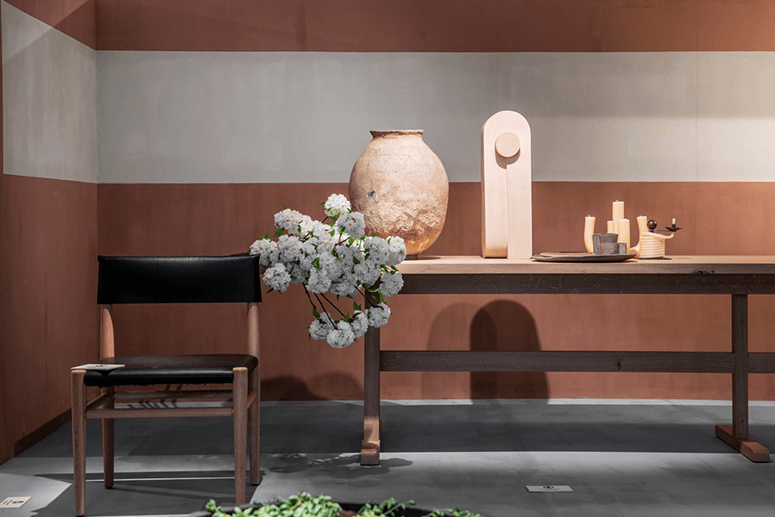Conscious, engaged, and kind design
The major social, economic and political upheavals that everyone is experiencing worldwide are inciting a call to stand up for our convictions, something that designers can no longer ignore. It encourages transparency, inclusivity and responsibility in reaching out to consumers, who are themselves more invested than ever in the way they engage with brands.
“It’s a time for straight talking, taking action, and being open-minded, even if that means beating a drum in order to drive forward change,” says Vincent Gregoire, a trend forecaster for the Paris design, decorating and lifestyle show Maison & Objet in Paris.
The recent edition of the trade fair challenged modern-day aesthetics of “what is beautiful and provided a springboard for what is good” through the banner theme of “Taking Care.” Taking care has become a veritable necessity at a time when we are all actively seeking meaning and tranquility.
Taking care
In choosing themes, Gregoire and his team at the Nelly Rodi Design Consultancy always take a close look at what’s happening in modern-day society.

“Today, the second we step outside, we are hit with cultural, environmental and identity issues,” observes Gregoire. “Society is craving new models, and that is something that brands can deliver, providing solutions that target the environment, safeguard expertise, or encourage us all to care for others or focus on our own wellbeing.”
Gregoire stays tuned to the rising voices that are picking up that gauntlet. Just like Greta Thunberg, the Swedish environmental activist, the under-25s who make up Generation Z are impatiently waiting for something to be done by those who have the power to do so. A new set of ethics is no doubt dictating consumer activity.

The trade fair itself sets a good example by recycling 50% of waste, using more LEDs, storing and reusing signage, donating unsold food to the Red Cross, sourcing water locally and turning down heating. Exhibitors have to defend pivotal values with a view to shaping a desirable and inclusive future.
Noma, a French design house, now works exclusively with recycled materials.
Art and craft furniture have become statement pieces and illustrate how following the slow-living tendency with handmade pieces can add value to interiors.
In the Philippines, Rags2Riches has been making eco-ethical pieces since 2007, upcycling overstock fabrics while partnering with communities of artisans. Originating in Payatas, the site of one of the largest garbage sites in the country, where the women would scavenge for fabric scraps to make into foot rugs, communities have been organized to craft world-class products by connecting them to garment factories and designers. Their latest collaboration is with New York-based Filipino designer Rafé Totengco, who designed a line of bags that utilizes the macramé technique in an open weave.
Taking care of yourself
Designers are now coming up with meaningful creations that take care not only of our bodies but also of our mental health, an answer to the demand for solutions dedicated to physical health, which suffered so much during the pandemic. The Nuage armchair is both a statement chair and one designed for wellness and relaxation with its soft fabrics and calming colors.

“In the Air,” curated by Elizabeth Leriche, encourages us to stop and take a breath through a lighthearted yet fully conscious and sustainable pause set in three phases: After a tribute to fresh, pure air in soft, blue shades with transparent furniture and accessories comes a meditative moment marked by slow design, then concluded by a luminous and colorful daydream of a new world.

The shift to strong red-yellow tones illustrates the trend of Bold Contrasts and Peaceful Coexistence. Gregoire says, “We’re in the era of simultaneity, with the color trends reflecting societal tensions by mixing two opposing shades —neutrals and vibrant colors bordering on extravagance and virtual reality.”

The coexistence trend is also seen in the major development where brands are designing furniture lines featuring pieces that can be used both indoors and out.
Taking care of nature
With many buyers looking for ways to tackle issues like ecology, many socially minded brands have come up with a brand new ethic that is finding a foothold with consumers, echoing the slow-living trend: La Fabrique à Sachets inspires us to give nature a helping hand by sowing our own seeds. Dopper is fighting the battle against the use of single-use plastic bottles with their attractive and ingenious reusable vessels. Knife-maker Jean Dubosc designs pieces whose handles are made from waste plastic.
“Grounded,” an exhibit by Francois Bernard, shines a light on the relationship between raw materials and nature, illustrating a new kind of luxury that favors simplicity and its healing sensory pleasures over gold and glitter.
Taking care of and showing an interest in others
Many brands are now committed to re-forging links between generations, social classes and cultures, which the show has always espoused with the “Rising Talents” exhibit such as this edition’s feature of Spanish talents who represent a socially minded generation with their creations echoing the desire to care for the world around us.
Taking care of heritage and expertise
The artisanal-revival trend is stronger than ever to safeguard traditional crafts and knowhow. Art and craft furniture have become statement pieces and illustrate how following the slow-living tendency with handmade pieces can add value to interiors by sharing cultural values and emphasizing quality.










